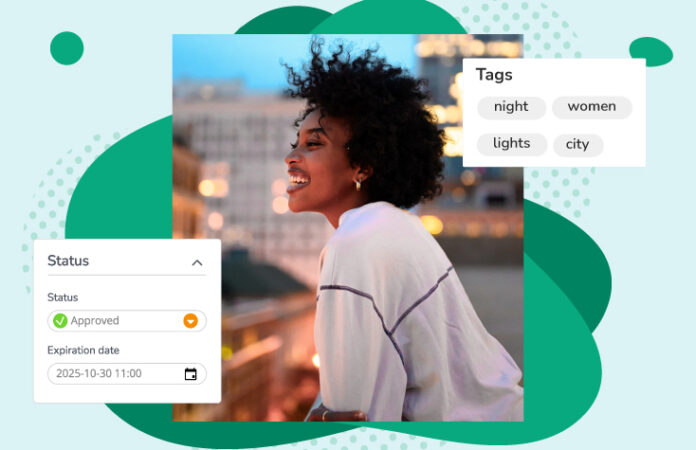
Today’s operating environment means we need to get to market faster to meet business demands. But it takes a long time to create branded assets and deploy multi-channel, targeted marketing campaigns. At the same time, consumer behavior and shopping preferences are constantly changing, and shoppers have high expectations of brands in a very crowded online and offline world.
For food & beverage retailers and manufacturers, the volume of digital content required to compete presents one of the greatest challenges. Managing imagery and video from suppliers, plus your brand’s own content, and being able to find all these files instantly later is burdensome. Documents, presentations, and spreadsheets all further contribute to the content challenge.
Instead of reliance on internal shared servers, or bulging Dropbox, Google Drive, or SharePoint folders, digital asset management (DAM) is solving this problem for many industry players. As a cloud-based software-as-a-service (SaaS) solution, anyone with permission can securely access and collaborate on the files and content they need. It’s all accessible through a web browser and offers a wide number of benefits to improve team and partner productivity.
Here are three reasons why retailers and manufacturers are now harnessing DAM technology to gain competitive advantage.
1. Go to market faster than ever before
It’s vital to ensure all your marketing and commercial teams and their agencies have access to precisely the files they need — and only what they need. DAM platforms have transformed the game when it comes to organizing, finding, and sharing digital content – meaning businesses can launch products and better manage brand consistency nationally and internationally.
For example, links can be provided to designers and photographers to upload imagery, which can be automatically tagged using technologies like image recognition and facial recognition, instantly organizing what or who is featured.
For streamlined distribution of content to partners, DAM offers the ability to create Portals. These are secure folders with controlled access to make available only the content assets you want to share, with only the people you want to have access to them. Portals can be fully customized to your brand design.
Inspirits Premium Drinks and La Martiniquaise Benelux use DAM to minimize internal and external asset requests. Their partners can quickly find all the logos, brand guides, and technical data sheets for the drinks brands in their portfolio using Portals. With a centralized library to draw from, teams can create competitive marketing campaigns to rival larger brands.
With a DAM platform, you can also streamline and automate content distribution to your website, e-commerce platform, and social media accounts. Assets are managed all in one place meaning faster page loading times, automatic image cropping to the perfect sizing for each platform, and automatic updates to an image wherever it appears on your website or ecommerce platform. These features ensure every image you put out looks its best, no matter where it appears, and improves speed to market by automating tedious tasks like resizing images and awaiting manual upload.
Building the right technology stack is foundational for today’s retail businesses. For marketing teams, Hootsuite, Canva, or Adobe’s Creative Suite are all likely to play a role among the various tools used to create and communicate your content. DAM integrates with these, meaning you can seamlessly push and pull content directly from your DAM library. This helps to streamline design and marketing from the start of product development or a marketing campaign to the very end of it.
2. Build and protect your brand identity
A strong brand creates trust, builds customer loyalty, and increases revenue, and in the digital age, your brand is more visible than ever, from physical storefronts to online ads and social media. Your brand must resonate with customers, whether they’re looking online or in person, and at the heart of this is brand consistency.
Implementing DAM as your single source of truth will ensure that everyone from internal teams to external agencies will always have access to your style guide in a single location. Because you can set specific permissions on assets and folders, your teams, and partners – through supply chain, distribution, design, and marketing – will only see what is approved and on-brand, ensuring your brand is always consistent and on point.
Contributors, such as graphic designers, have direct access to approved brand guidelines and assets – making it easy to make the right creative decisions. Brand managers have central oversight and can easily remove off-brand or outdated content from circulation. Built-in approval statuses and review tools ensure only on-brand, approved content makes it out into the world.
For example, with DAM, Godiva Chocolatier provides quick access to previous packaging designs to its teams, so that if they want to recreate or avoid duplicating a design, all the information is in one easy-to-navigate place.
3. Increase your content ROI while future-proofing your business
As your business grows, how your tech stack will evolve with you should be top of mind. Ensuring your team and partners are ready as you ramp up means having the right tools for the job. DAM provides unparalleled search functionality, allowing your team to search by tags, metadata, keywords, categories, author, comments, and more. The better you can find and organize content, the easier it will be to reuse and repurpose, allowing your team and external partners to create more excellent, quality content and improve your creative and content workflows.
DAM makes it easier to expand into new markets without reinvesting to create new content for new markets. Portals mean you can share specific content with colleagues or distributors in specific markets. And, for example, built in transcription features can translate approved content into multiple languages to speed up localization.
A DAM platform can also manage your digital rights. Many retailers work with product photography that has strict usage guidelines. Using outdated, expired, or unapproved imagery or content can result in fines, penalties, or damaged partnerships. Digital rights management capabilities in DAM platforms can restrict access, enforce usage expiration, and track the usage of brand assets to ensure everything is used within agreed parameters before mistakes are made.
Digital asset management is a trusted industry tool
Today, retailers face the challenge of attracting customers to physical stores or the online marketplace as well as considering new markets to expand into. To create a strong brand reputation and customer loyalty, brand identity must remain consistent across entities and platforms. With more retailers and manufacturers turning to digital asset management, it’s easier to produce on-brand assets, quickly launch campaigns, and update existing collateral. It’s about using the latest technology to ensure your teams are working at their best.
 Mike Paxton is Chief Revenue Officer, EMEA & APAC at Canto where he leads a team of digital asset management experts. Canto helps teams to work faster and smarter as they manage, create and share digital content.
Mike Paxton is Chief Revenue Officer, EMEA & APAC at Canto where he leads a team of digital asset management experts. Canto helps teams to work faster and smarter as they manage, create and share digital content.
Mike started his career in operations for the London Metropolitan Police before working in software and equipment procurement for British animal charity, the RSPCA. It was here he learned the importance of working with reliable technology partners – an ethos he has developed at Canto.






